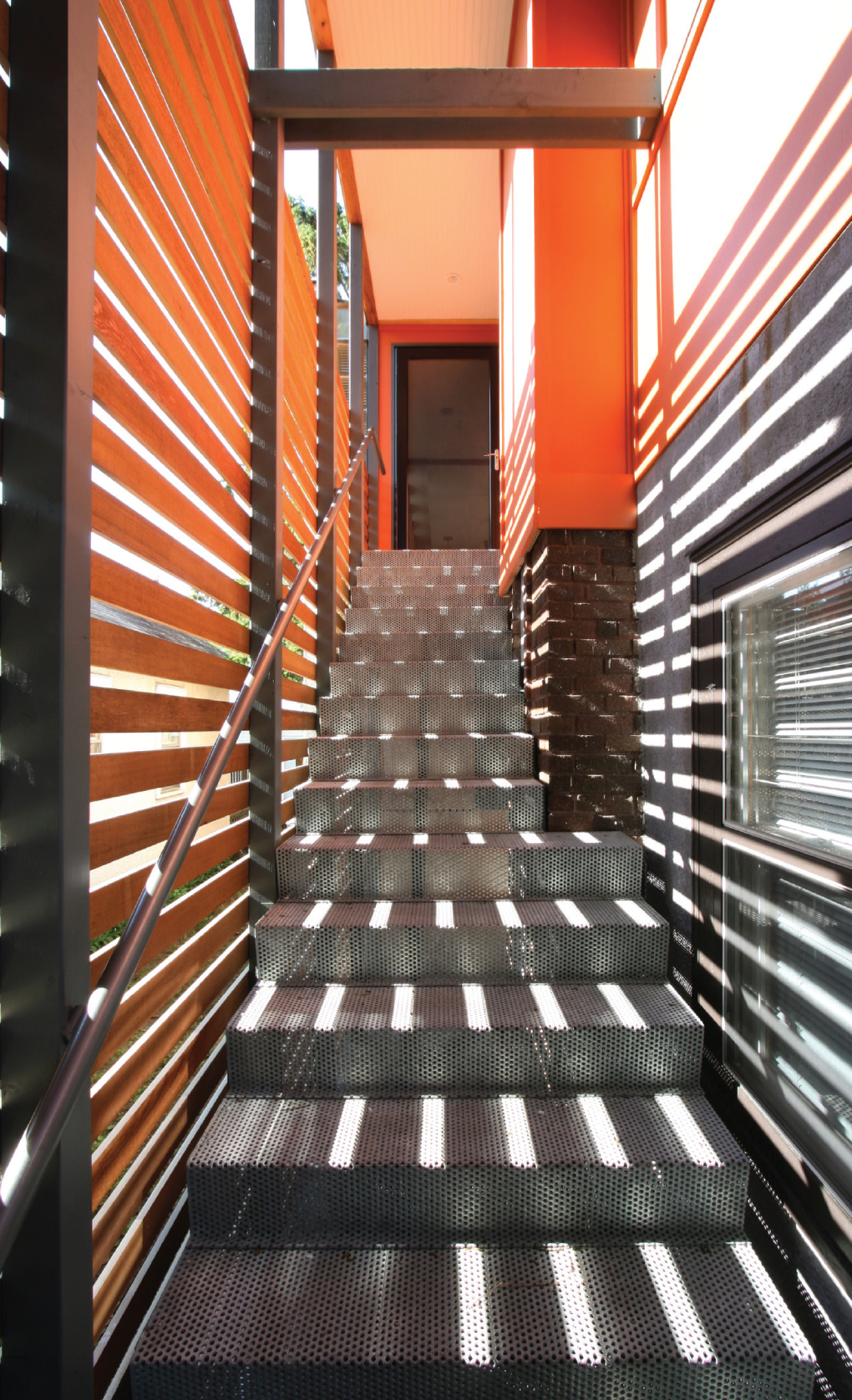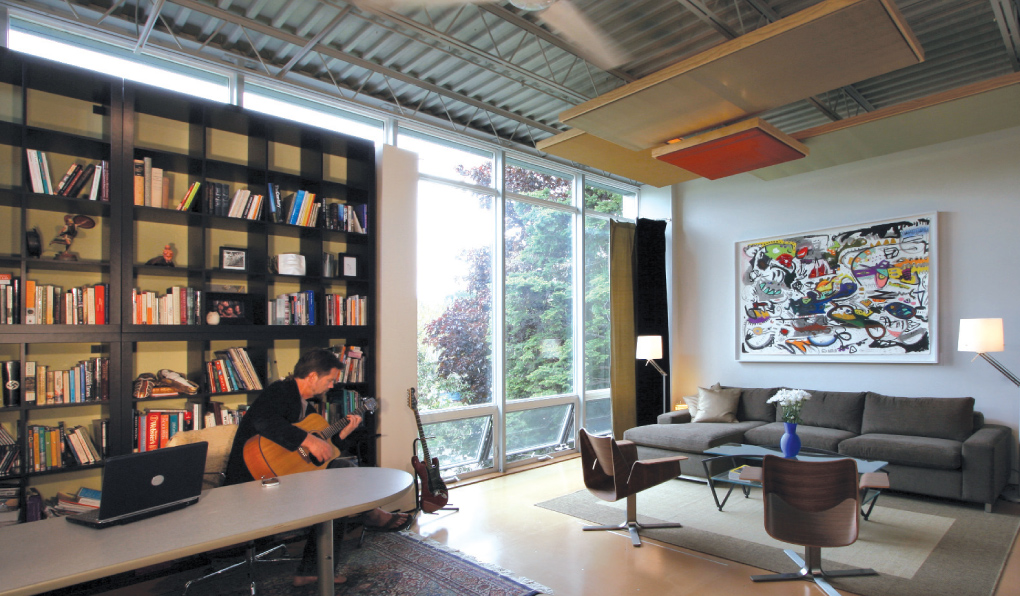
Above: “I do feel as though I’ve done things backward, but I’ve had so many wonderful and varied experiences along the way,” says Michael Roehr. Photo by David Bowman.
The irony of accolades as an “emerging talent” isn’t lost on Michael Roehr, who co-founded the residential design/build studio Joyce/Roehr Design (with Ward Joyce) in 1994 after earning his master’s in architecture from the University of Minnesota. Life just kept getting in the way.
After Joyce moved out of the Twin Cities, Roehr’s friend Chris Schmitt encouraged him to join HGA. For five years, Roehr worked closely with architect Tim Carl on a range of corporate projects for General Mills, including interiors, the employee-services building, and the conference center. (Carl was recently named HGA’s new chief executive and a fellow of the American Institute of Architects. “Yes, he ascended,” Roehr says with a laugh, “and I emerged.”)
 Left: Upper-level living spaces, with a sliding door to close off the office, in the Burnham Road house provide both prospect and refuge. Photo by Scott Gilbertson.
Left: Upper-level living spaces, with a sliding door to close off the office, in the Burnham Road house provide both prospect and refuge. Photo by Scott Gilbertson.
Roehr and his wife then decided to move with their two young children to Mexico for a year and a half. He had earned his first degree in philosophy and comparative literature from the University of Wisconsin-Madison and was yearning to write a novel. His wife had writing projects of her own. “We wanted to learn another language, savor being a young family, and create a benchmark in our family history,” he explains.
They returned to Minnesota broke, “which was the plan,” he says. He and Schmitt were ready to start their own firm, but then Ryan Companies asked Roehr to be its new senior designer “and spearhead a cultural change,” Roehr recalls. “They made an offer I couldn’t refuse, and I brought Chris along. We hired new staff, established new standards, and re-envisioned their design department. Meanwhile, we continued planning our firm, learning what we could.”

Above: Light plays with shadow in the sheltered entry to Roehr’s own St. Paul house. Photo by Scott Gilbertson.
In 2006, RoehrSchmitt Architecture opened for business in Northeast Minneapolis, doing both residential and commercial projects. Roehr had been working on his own home on Juliet Avenue in St. Paul, transforming a 1926 bungalow on a narrow lot into a simple, modern home with living areas on the upper level and bedrooms below. One day, he found a handwritten note in the mailbox. “It was a love letter to my house,” he says. “The writers wanted to know if I could do something similar for them, a few blocks away.”
 Left: Roehr used just a few materials to break up the massing of this modern exterior. Photo by Scott Gilbertson.
Left: Roehr used just a few materials to break up the massing of this modern exterior. Photo by Scott Gilbertson.
Roehr took the same approach with their house, working with a simple rectangular form and a handful of materials on the exterior to break down the massing. He let the clients’ desires for light, views, and privacy drive the window size and placement.
The architect also “customized what was otherwise just a box with cool details that made our house original, without being outrageously expensive,” says former owner Michelle Wall (the family has since moved to a different home). Roehr organized the master bedroom as a family room. He also suggested inexpensive perforated steel for a transparent wall and as a decorative element on the kitchen island, and tucked a skinny glass-block window by the front door.

Above: The Burnham Road house features upstairs living spaces, lots of light, and expansive views. Photo by Scott Gilbertson.
For a Burnham Road house, which sits on a triangular hilltop off the canal between Lake of the Isles and Cedar Lake in Minneapolis, he again put the living spaces on the upper level. In addition to optimal natural light, breezes, and views, he says, the elevation “gives the owners a sense of prospect and refuge. They have visual command of the environment, as they can see out more than people can see in.”
While his path may seem unorthodox—“I do feel as though I’ve done things backward, but I’ve had so many wonderful and varied experiences along the way”—Roehr treasures his relationships with residential clients. He appreciates the opportunity to “create a space of trust and collaboration that elicits the best of everyone involved.”
A home is a deeply personal experience, he says, “especially while people are engaged in the process of working with an architect, talking through how they live, what they do, how they envision living in the new home, and how that will change over time. In turn, the design process becomes an extension of their family, embracing how their dreams will evolve over the years, their kids will grow, and their careers will change. That’s far more satisfying to me than concocting stories on paper.”

Above: Roehr transformed his own 1926 bungalow into a modern home with open living areas on the upper floor. Photo by Scott Gilbertson.
Roehr’s Favorites
ARCHITECTURAL STYLE
Modern, but with the caveat that I think of modern as less a style per se than the vaguely form-follows-function method of working that generally results in something that we’d call “modern.”
TWIN CITIES NEIGHBORHOOD
Hard question—there are so many great ones. I love my neighborhood of 30-plus years, Mac-Groveland. But I’m very attracted to Linden Hills. And I love the downtown/warehouse district/North Loop areas. And Lowertown…
LOCAL PUBLIC BUILDING
Let’s call it “an architectural experience,” which for me in this town is standing in the middle of the Stone Arch Bridge and paying witness to the history and the future of Minneapolis unfolding all around you.
DESIGN INSPIRATION
Everything—usually stuff other than architecture: books and art and music and food, especially food. I’m probably more inspired by how local chefs plate their creations than by how other architects ply their trade.
INTERNATIONAL CITY
New York City—in my mind, it’s the most international city. Runners-up are Paris, Amsterdam, Bologna, Italy, and Jerusalem.
ROOM TO DESIGN
In residential, probably the kitchen, as I love to cook. And perhaps the best way to really get to know a client is to understand their rituals around cooking and dining. In open-plan designs, the kitchen is typically the anchor and driver for the rest of the living areas.
DESIGN TRENDS
Simplicity and clean, transparent functionality. Less of everything.
MATERIAL TRENDS
I see lots of activity around composites, hybrids, and “smart” materials—all of which are interesting—but I find myself and most of my clients still respond best to real stuff: wood, stone, porcelain, metal, and glass.
Read more: Minnesota’s Best Architects 2015
By Camille LeFevre
Architect: Michael Roehr




















